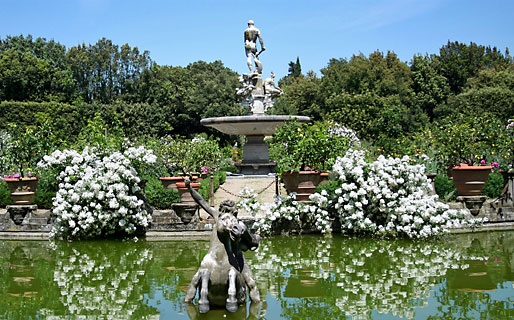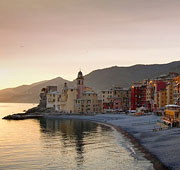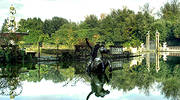Florentine gardens
From the Boboli Gardens to the Park of Cascine, a journey through the green heart of Florence

Italian art city par excellence, Florence is also a surprisingly green metropolis, home to numerous splendid gardens. Here, each and every fine day is an occasion to enjoy the colours, perfumes and tranquillity of the parks and gardens of the Tuscan capital.
Simply beautiful
This green itinerary starts in the magnificent Giardino dei Semplici, the city's Botanical Garden. Founded in 1545 by Cosimo I de' Medici, the garden extends over more than two hectares of land, most of which covered by greenhouses. Today, the Botanical Garden continues to cultivate numerous varieties of officinal plants, the so-called semplici, after which the garden was named. At the center of the garden, a stone fountain with water-spitting putto takes pride of place amidst ponds home to an amazing collection of aquatic plants.
Boboli and Bobolino
The next part of our journey takes us to Florence's Giardino di Boboli: 45 thousand square meters of greenery, right in the heart of the city.
Annexed to the Palazzo Pitti, the Boboli Garden is one of the most famous formal 16th century Italian gardens and a veritable open air museum, with a unique architectural plan and dozens of statues hiding amidst the multicoloured plants.
The garden has a triangular plan, with two, steeply sloping orthogonal axes, which terminate in the Bacino di Nettuno (fountain of Neptune). Approximately three hours are necessary to visit the whole of the Boboli Garden.
Not far away from the Boboli Garden we find its smaller twin, the Bobolino: a public park structured like a hanging garden and characterised by grassy slopes, ponds and artificial caves
Torrigiani and Cascine
The Torrigiani Garden, not far from the Bobolino, is a private property open to the public. The garden was designed by Luigi Cambray-Digny and completed by Gaetano Baccani who, in the 19th century, added the neo-gothic tower which has become the garden's hallmark. On the summit of the tower there is a small observatory from where to admire the stars.
Moving away from the center of Florence, we head towards the Cascine. Duke Alexander purchased the land in the mid 16th century, creating a cattle farm and hunting estate later enlarged by Cosimo I de' Medici. Towards the end of the 18th century, the Cascine was transformed in public park: 160 hectares of park facing the right-hand bank of the river Arno.
In 2003 the park's restored Velodrome, named in honour of the legendary, Florence-born cyclist, Gino Bartali, was inaugurated.
Irises and Roses
Finally, a delightful garden dedicated to the symbol of Florence, the "Giglio" or Iris. For those finding themselves in Florence during the month of May, a visit to the Giardino dell'Iris is an absolute must. It is in May that the garden opens its doors to the public, thus allowing visitors to witness the flowering of more than 2 thousand varieties of Iris.
The Iris became the symbol of Florence in the 12th century when its stylised representation appeared on the first silver coins of the Florentine Republic
The garden is situated just steps away from Piazzale Michelangelo, panoramic terrace from where to enjoy one of the most beautiful views of the Tuscan capital.
Close by, and again only in the month of May, visitors can admire the Garden of Roses in flower.












